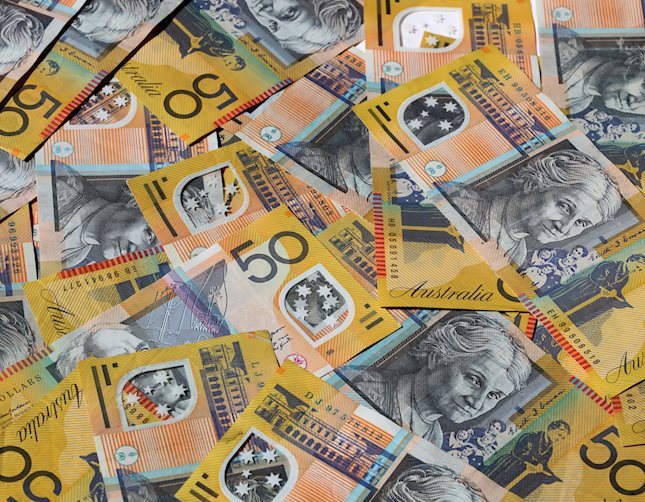AUD/USD Forecast and News
AUD/USD: Upside appears capped at 0.6300 on Trump's tariff fallout
AUD/USD struggles to build on the previous day's rebound and remains below the 0.6300 mark early Wednesday, anticipating US President Trump's tariffs announcement later in the day. However, buyers continue to draw support from China's stimulus optimism and RBA's prudence on the policy outlook.
Latest Australian Dollar News
AUD/USD Technical Overview
A clean break above the 2025 high at 0.6408 (February 21) could open the door for a test of the 200-day SMA at 0.6505. Beyond that, the November 2024 peak of 0.6687 stands as the next key resistance.
On the other hand, if sellers regain the initiative, the March low at 0.6186 (March 4) serves as the first support. A decisive move below this level paves the way for a potential retest of the 2025 trough at 0.6087, with the psychologically important 0.6000 mark on deck.
The RSI regains some impulse and flirts with the 47 level, signalling that some upside momentum appears to be shaping up. However, a muted ADX reading near 11 suggests the overall trend remains somewhat weak in conviction.
Fundamental Overview
The Australian Dollar (AUD) managed to regain some balance, leaving behind two daily pullbacks in a row vs. the US Dollar (USD), including a pessimistic start to the week.
That said, Tuesday’s respite sent AUD/USD back to the 0.6280-0.6285 band, a region coincident with the transitory 55-day SMA, despite intense concerns surrounding the US trade policy, particularly ahead of the so-called “liberation day” on April 2.
Tariff tensions cloud the outlook
Despite periodic flashes of optimism, the spectre of additional US trade measures continues to cloud market outlooks, as the White House is expected to announce reciprocal tariffs on April 2. Against that, fresh tariffs threaten to trigger retaliatory moves from major US trading partners, further souring investor sentiment and weighing on risk assets.
The Aussie, which is closely linked to both global risk appetite and Chinese demand for commodities, is particularly vulnerable. Any signal of slower growth in China can ripple through the Australian economy, potentially dragging down GDP and putting pressure on the currency.
Still around China, an unexpected improvement in the Caixin Manufacturing PMI in March (51.2) also lent some oxygen to the Aussie Dollar, further bolstering the uptick in spot.
Fed's balancing act amid trade uncertainty
The Federal Reserve (Fed) is grappling with a delicate balancing act. On one hand, ongoing trade tensions could fan inflation, potentially justifying prolonged higher interest rates. On the other, early indicators of a cooling US economy suggest caution—despite a still-robust labour market.
On March 19, the Fed left its benchmark rate steady at 4.25–4.50% and reiterated a “wait-and-see” approach. Fed Chair Jerome Powell stressed the need for patience, even though the central bank’s forecasts signal slower growth and slightly higher inflation ahead—some of which could stem from tariff pressures.
RBA's cautious stance on rate moves
Meanwhile, the Reserve Bank of Australia (RBA) left its Official Cash Rate (OCR) at 4.10%, as widely anticipated, early on Tuesday.
However, the central bank made it clear that it’s in no rush to resume easing. In a notable departure from its February stance, the central bank removed the sentence that stated, “the Board remains cautious on prospects for further policy easing.” Instead, officials emphasised that while the steady decline in underlying inflation is encouraging, persistent risks on both sides mean the outlook remains uncertain.
At the press conference, RBA Governor Michele Bullock admitted that the Board does not have “100% confidence” that inflation is moving sustainably toward the 2–3% target range. Bullock confirmed that the decision to hold rates was reached by consensus, with no explicit discussion of a rate cut.
Following the RBA gathering, odds of a 25 basis points cut at the May 20 meeting fell to 70% from 80% prior to the announcement.
Growing bearish bets on the Aussie
Bearish bets on the Aussie are mounting. The latest CFTC report shows net short positions at nearly 80K contracts (as of March 25), a multi-week high that’s been building since mid-December, fuelled by escalating tariff worries.
SPECIAL WEEKLY FORECAST
Interested in weekly AUD/USD forecasts? Our experts make weekly updates forecasting the next possible moves of the Australian Dollar-US Dollar pair. Here you can find the most recent forecast by our market experts:

AUD/USD: Interim top confirmed, 0.7000 at risk Premium
The AUD/USD pair kept falling in the last few days, reaching a fresh multi-week low of 0.7263 on Friday, to close the trading week a handful of pips above it.
AUD/USD Big Picture
AUD/USD Bullish Themes
AUD/USD Bearish Themes
Latest AUD Analysis
Editors' picks

EUR/USD drops below 1.0800 on Trump's 'Liberation Day'
EUR/USD is back in the red below 1.0800 in the early European morning on Wednesday as investors rush for the safe-haven US Dollar, aniticpating US President Donald Trump’s long-threatened “reciprocal” tariffs package, due to be announced at 20:00 GMT.

GBP/USD trades with caution above 1.2900, awaits Trump’s tariffs reveal
GBP/USD is trading with caution above 1.2900 early Wednesday, struggles to capitalize on the overnight bounce amid resugent haven demand for the US Dollar. Traders remain wary heading into the US 'reciprocal tariffs' announcement on "Liberation Day' at 20:00 GMT.

USD/JPY holds losses below 150.00 as traders await Trump's tariffs
USD/JPY stays defensive below 150.00 in Wednesday's Asian trading as traders turn cautious ahead of Trump's reciprocal tariffs announcement. A cautious market mood and BoJ Ueda's comments underpin the Japanese Yen, keeping the pair under pressure amid a subdued US Dollar.

Gold price remains close to record high amid concerns over Trump’s reciprocal tariffs
Gold price regains positive traction amid concerns about Trump’s aggressive trade policies. Fed rate cut bets keep the USD bulls on the defensive and further benefiting the XAU/USD pair. A broadly stable risk sentiment might cap gains ahead of Trump’s tariffs announcement.

WTI remains capped below $71.00 as Trump’s tariffs loom
West Texas Intermediate, the US crude oil benchmark, is trading around $70.95 during the early Asian session on Tuesday. The WTI price edges higher amid supply worries after US President Donald Trump threatened Russia with oil tariffs.
Majors
Cryptocurrencies
Signatures
AUD/USD YEARLY FORECAST
What would happen to the AUD/USD this year? A brief update from our experts on where the AUD/USD can go in the upcoming months.
AUD/USD FORECAST 2025
The battle between the Australian Dollar (AUD) and the US Dollar (USD) will be one worth watching in 2025, with central banks stealing the limelight. The Reserve Bank of Australia (RBA) has kept interest rates at record highs whilst most of its overseas counterparts started the loosening process. The US Federal Reserve (Fed), on the other hand, has trimmed the benchmark interest rate by 100 bps through 2024 and aims to slow the pace of cuts in 2025. The central banks’ imbalance aims for record lows in AUD/USD.
MOST INFLUENTIAL POLITICAL EVENTS IN 2025 FOR AUD/USD
Beyond central banks, market players will be attentive to tariffs. The second coming of Donald Trump to the White House anticipates a global Trade War that could fuel inflationary pressures not only in the United States, but also in all major economies.
Given Trump’s personal battle with China, the Australian economy could end up benefiting from fresh commercial interactions with its neighbour giant.
About AUD/USD
AUD/USD, The 'Aussie'
The AUD/USD pair, also called the “Aussie”, tells the trader how many US dollars (the quote currency) are needed to purchase one Australian dollar (the base currency). This currency pair is also known as the "Aussie". Together with the New Zealand Dollar and the Canadian Dollar, the AUD is a commodity currency, that is a currency whose country's exports are largely comprised of raw materials (precious metals, oil, agriculture, etc.).
The interest rates set by the Reserve Bank of Australia (RBA) have been among the highest of industrialized countries and the relatively high liquidity of the AUD has made it an attractive tool for carry traders looking for a currency with the highest yields. These factors made the AUD very popular among currency traders.
AUD/USD CORRELATIONS
Australia is a big exporter to China and its economy and currency reflect any change in the situation in that country. The prevailing view is that the Australian Dollar offers diversification benefits in a portfolio containing the major world currencies because of its greater exposure to Asian economies.
This correlation with the Shanghai stock exchange is to be added to the correlation it has with gold. The pair AUD/USD often rises and falls along with the price of gold. In the financial world, gold is viewed as a safe haven against inflation and it is one of the most traded commodities.
ORGANIZATIONS, PEOPLE AND ECONOMIC DATA THAT INFLUENCE AUD/USD
The AUD/USD news can be seriously affected by the decisions taken by these organizations and people:
- Reserve Bank of Australia (RBA) that issues statements and decides on the interest rates of the country. Its president is Michele Bullock.
- Australian Government and its Department of Finance that implement policies that affect the economy of the country.
- The US Government: events as administration statements, new laws and regulations or fiscal policy can increase or decrease the value of the US Dollar and the currencies traded against it, in this case, the Australian Dollar.
- Fed, the Federal Reserve of the United States whose president is Jerome Powell. The Fed controls the monetary policy, through active duties such as managing interest rates, setting the reserve requirement, and acting as a lender of last resort to the banking sector during times of bank insolvency or financial crisis.
In terms of economic data, as for most currencies, the AUDUSD traders have to keep an eye on:
- GDP (Gross Domestic Product), the total market value of all final goods and services produced in a country. It is a gross measure of market activity because it indicates the pace at which a country's economy is growing or decreasing. Generally speaking, a high reading or a better than expected number is seen as positive for the AUD, while a low reading is negative.
- Inflation measured by key indicators as the CPI (Core Price Index) and the PPI (Production Price Index), which reflect changes in purchasing trends.
- Current Trade Balance, a balance between exports and imports of total goods and services. A positive value shows trade surplus, while a negative value shows trade deficit. If a steady demand in exchange for AUD exports is seen, that would turn into a positive growth in the trade balance, and that should be positive for the AUD.
Michele Bullock
Michele Bullock is an Australian economist who is currently governor of the Reserve Bank of Australia. She commenced as governor on 18 September 2023, and is the first woman to hold the role. She is Chair of the Reserve Bank Board, Payments System Board and Council of Financial Regulators. Prior to her current role, Ms Bullock was the Deputy Governor of the Reserve Bank of Australia.
Michele Bullock RBA's Profile and Wikipedia
Jerome Powell
Jerome Powell took office as chairman of the Board of Governors of the Federal Reserve System in February 2018, for a four-year term ending in February 2022. His term as a member of the Board of Governors will expire January 31, 2028. Born in Washington D.C., he received a bachelor’s degree in politics from Princeton University in 1975 and earned a law degree from Georgetown University in 1979. Powell served as an assistant secretary and as undersecretary of the Treasury under President George H.W. Bush. He also worked as a lawyer and investment banker in New York City. From 1997 through 2005, Powell was a partner at The Carlyle Group.
Jerome Powell Fed's Profile and Wikipedia
RBA NEWS & ANALYSIS
FED NEWS & ANALYSIS
ASSETS THAT INFLUENCE AUD/USD THE MOST
- Currencies: NZD and JPY (New Zealand and Japan are important regional partners of Australia). Other important group of influent pairs includes: EUR/USD, GBP/USD, USD/JPY, USD/CHF, NZD/USD and USD/CAD.
- Commodities: The most important is Gold, as already explained above, but also Iron Ore and Natural Gas.
- Bonds: GACGB10 (Australian Government Bonds Generic Yield 10 Year), GNZGB10 (New Zealand Government Bond 10 Year) and T-NOTE 10Y (10 year US Treasury note).
- Indices: S&P/ASX 200 (stocks of the Australian Securities Exchange), S&P/TSX Global Gold Index (includes producers of gold and related products at the Toronto Stock Exchange).